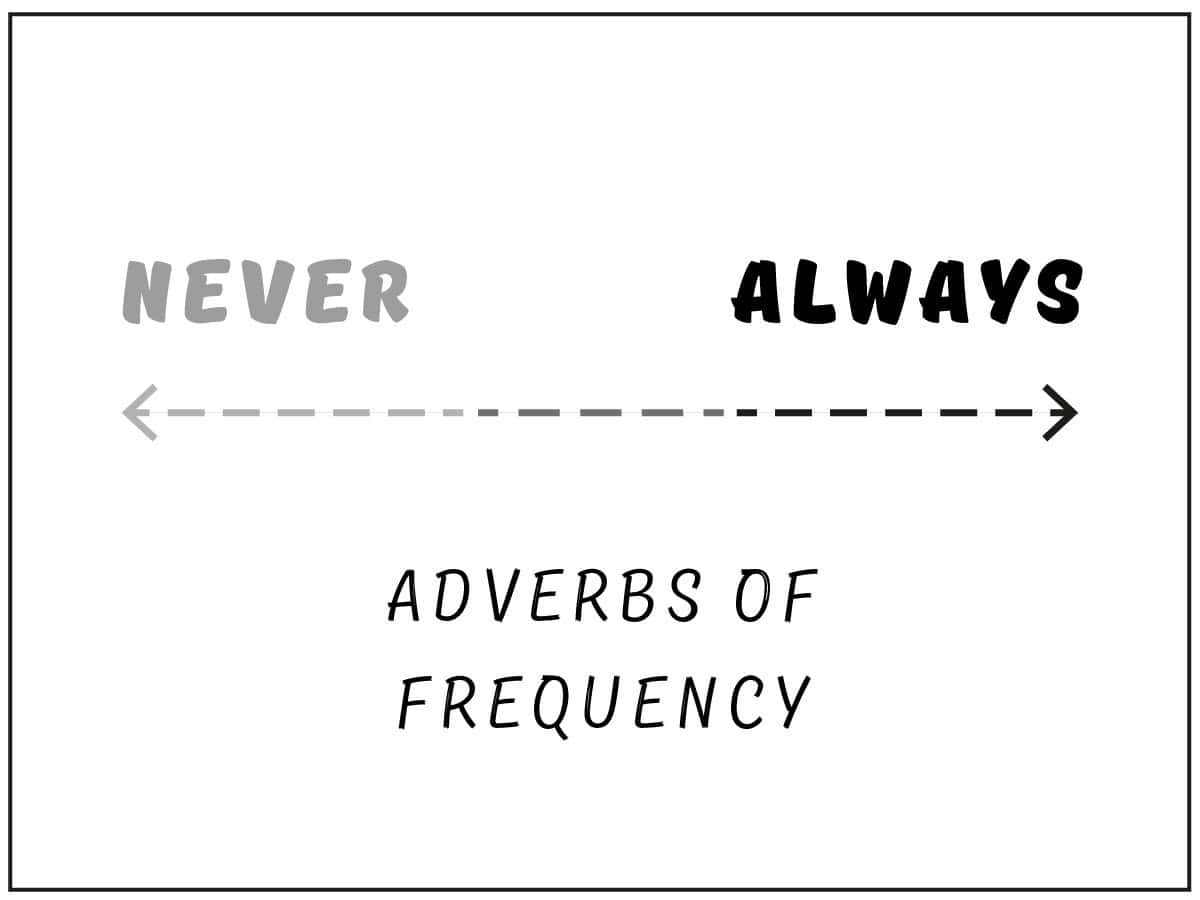Adverbs of frequency show how often something is done. They have a special position in a sentence and convey different meanings in positive and negative contexts.
Adverbs of frequency answer the question “How often …?”
The range of frequency is from very frequently (always) to something not done at all (never).
Adverbs of frequency : from always to never

Adverbs of frequency position
We usually put the adverbs of frequency :
- between the subject and the simple present verb
- after “be” in the simple present (am, is, are) and simple past (was, were)
For example :
However, some of them may also occur at the beginning and the end of a sentence.
At the beginning
Some adverbs of frequency that may occur at the beginning : generally, sometimes, occasionally. We put a comma after them.
For example :
- Generally, I prefer working alone.
- Sometimes, she stays at home on the weekend.
- Occasionally, we have lunch together on Sundays.
At the middle
Most of the adverbs of frequency occur at the middle of the sentence. No comma is needed.
For example :
- I always brush my teeth before going to bed.
- She is almost always on time for her appointments.
- We usually have dinner together as a family.
- They often go swimming during the summer.
- He frequently travels for work.
- I generally prefer working alone.
- She sometimes stays at home on the weekend.
- We occasionally have lunch together on Sundays.
- Have you ever visited Paris?
- He seldom forgets his keys.
- It rarely snows in this part of the country.
- She hardly ever watches TV.
- They are almost never late for meetings.
- I have not ever been to Asia.
- Jim never meets his grandparents.
At the end
Often, frequently, sometimes, and occasionally can be put at the end of a sentence.
For example :
- They go swimming during the summer often. (not common)
- He travels for work frequently.
- She stays at home on the weekend sometimes.
- We have lunch together on Sundays occasionally.
Adverbs of frequency in negative sentence
In a negative sentence, most adverbs of frequency come directly after the subject (except always and ever).
For example :
(+) Brianna usually eats breakfast.
(-) Brianna usually doesn’t eat breakfast.
“Always” follows a negative helping verb.
For example :
(+) Pamela always goes to sleep early.
(-) Pamela doesn’t always go to sleep early.
“Always” also follows the negative “be”.
For example :
(+) Pamela is always happy at work.
(-) Pamela isn’t always happy at work.
“Ever” means “at any time”. It’s used with not, which has a negative meaning.
But, “never” is more common than “not ever”.
For example :
No one ever told me about the accident. (The word “no one” conveys the negative meaning.)
I do not ever/don’t ever walk to school. (acceptable)
I never walk to school. (more common)
Adverbs of frequency in question
In a question (interrogative sentence), they come directly after the subject.
We usually use “ever” to ask about frequency. The answer uses an adverb of frequency depending on how often that something is done.
For example :
A : Do you ever walk to school?
B : Yes, I do. I often walk to school.
A : Have you ever heard of SpaceX?
B : No, I haven’t. I’ve never heard of it.
Common mistakes
1. Negative adverbs of frequency are not used with a negative verb.
For example :
Brianna doesn’t never eat Mexican food. (wrong)
Briana never eats Mexican food. (correct)
2. Ever is not used in a statement.
For example :
I ever walk to school. (wrong)
I sometimes walk to school. (correct)
Note : change the word “ever” with another frequency adverb with positive meaning.
3. Unlike the modals, adverbs of frequency don’t change the subject-verb agreement.
For example :
She usually wear a hat to school. (wrong)
She usually wears a hat to school. (correct)
Conclusion
- Adverbs of frequency show how often something is done.
- Adverbs of frequency usually come between the subject and the simple present verb.
- “Be” in the simple present (am, is, are) and simple past (was, were) comes before adverbs of frequency.
- In a negative sentence, most adverbs of frequency come directly after the subject (except always and ever).
- “Always” follows a negative helping verb or negative “be”.
- Negative adverbs are not used with a negative verb.
If you need to drill on this topic, head to the British Council to get some exercise.
Do you sometimes confuse adverbs with adjectives?
Well, don’t be. Go to my post Adjectives and Adverbs : Easy Examples to Know the Difference.
Grammar book reference
Azar, Betty Schrampfer. Fundamentals of English Grammar: With Answer Key. Longman, 2003.
DK. English for Everyone: English Grammar Guide: A Comprehensive Visual Reference. DK Publishing (Dorling Kindersley), 2016.
What can I do for you?
Everything takes time, and each person has a different pace. Learn at your own speed. If you need help with your studies, feel free to connect with me. Even better, subscribe to my email list to stay updated!

